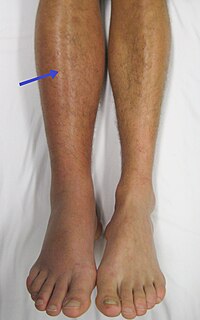
Photo from wikipedia
Heparin remains a commonly used anticoagulant in prophylaxis and treatment of venous and arterial thrombosis, in addition to ensuring patency of artificial blood circuits such as cardiopulmonary bypass (CPB). Heparin… Click to show full abstract
Heparin remains a commonly used anticoagulant in prophylaxis and treatment of venous and arterial thrombosis, in addition to ensuring patency of artificial blood circuits such as cardiopulmonary bypass (CPB). Heparin induced thrombocytopenia (HIT) is a rare but potentially fatal complication of heparin therapy that results from production of polyclonal antibodies to heparin in complex, usually with platelet factor 4 (PF4). In a proportion of patients, this causes platelet activation and thrombin generation, which may result in thrombosis. However, identification of patients with HIT can be complicated as thrombocytopenia is common in hospitalised patients receiving heparin, and is usually due to other causes. Clinical assessment of the likelihood of HIT is paramount in order to make appropriate decisions regarding laboratory investigations and ongoing anticoagulation, especially given clinically expressed pro-thrombotic states. However, clinical assessment, on its own, cannot guarantee diagnosis or exclusion of HIT, and therefore is facilitated by laboratory testing, although unfortunately, this is frequently limited by local availability of assays and delay in availability of results. Nevertheless, there are an increasing number of available laboratory tests that can be used to identify antibodies causing HIT, including both immunological and functional assays. This narrative review will discuss the existing tools for clinical assessment in addition to evaluating the advantages and disadvantages of the available laboratory assays for HIT.
Journal Title: Pathology
Year Published: 2017
Link to full text (if available)
Share on Social Media: Sign Up to like & get
recommendations!